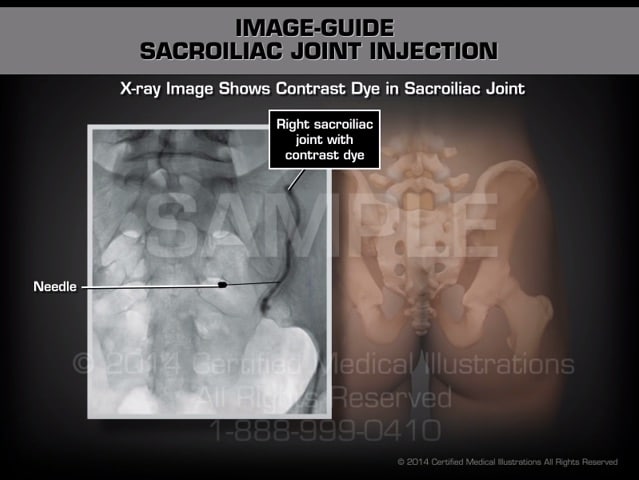SACROILIAC JOINT STEROID INJECTIONS
PLANO PAIN RELIEF DOCTOR
Home » Treatments » Sacroiliac Joint Steroid Injection
PAIN MANAGEMENT TREATMENT OPTIONS
Chronic Pain Treatment
The Pain Relief Center in Plano, Texas offers Sacro-Iliac Joint Steroid Injections for chronic pain treatment. Call us today for more information or to schedule an appointment.
What is a Sacro-Iliac Joint Steroid Injection?
A sacroiliac joint injection (also known as a sacroiliac joint block) is an injection of steroid medications and a local anesthetic into the affected area with the guidance of a fluoroscopy (a specialized x-ray) to confirm placement. This type of injection is used to both diagnose the source of pain in a patient and to provide therapeutic relief from pain symptoms. It is primarily used in the diagnosis and treatment of low back pain and sciatica symptoms related to sacroiliac joint dysfunction.
There are two sacroiliac joints in the body: one on the right and one on the left, located between the sacrum and the ilium of the pelvis. These joints connect the sacrum to the hip on both sides, and they play a strong and pivotal role in transferring weight and forces between the upper body and legs. These joints help with shock absorption and prevent impact forces from harming the spine.
How is it done?
Prior to beginning of the procedure, the injection site is cleansed with an antiseptic and the skin is numbed using a local anesthetic. Using advanced imaging technology, a special needle is then inserted into the affected joint where the nerve reaches it. The physician will use fluoroscopy to help guide the needle. An anesthetic and steroid will then be injected into the joint, the needle will be removed, and the injection site is cleansed and bandaged.
What should I expect?
The procedure itself takes 15 to 20 minutes to complete, and then there is an additional time period of recovery. Many patients experience immediate pain relief due to the numbing effect of the local anesthetic. Once the numbing medication has worn off, the pain might return. The steroid medication can take up to 3 days to take effect and will provide sustained pain relief. The results of this type of procedure can last anywhere from days to months, depending on the patient and their condition. Additional injections may need to be repeated if the patient suffers from a greater degree of long-term pain.
What should I expect the day of the procedure?
You are expected to arrive at the surgery center at least one hour before your procedure is scheduled. Bring a responsible adult driver with you because you will be receiving medications and this could impair your ability to drive. Do not eat or drink anything for 6 hours prior to your procedure. Please take your regularly scheduled blood pressure and heart medications with a sip of water as you normally would. If you have diabetes, take 1/2 of your normal dosage and bring your insulin with you.
After you arrive, you will be asked to sign in and complete any paperwork as needed. You will then be taken to the PreOp area. At this time, a nurse will ask you some questions and have you sign your consent forms. It is imperative that you, the patient, inform the nurse of any changes in your history and/or physical, such as the recent flu or have any health problems that might affect your procedure. Inform the staff if you are allergic to betadine. You will then be asked to change and then you will be assisted to the PreOp room or to a stretcher where your blood pressure, heart rate, temperature, and oxygen saturation will be done. An IV will be started (if ordered by your physician). Your belongings will be put away in a cabinet.
The anesthetist will talk to you before your procedure. You will then be prepped and positioned. The physician will perform the procedure. You may be given medication before and/or during your procedure to help you relax. You may doze off during this time.
Afterwards, the nurse will cleanse off the prepping solution and apply the dressings/bandages as needed. You will be transported to the recovery room area where you will be monitored anywhere from 20 minutes to an hour. When you are awake enough, you will be offered beverages and some crackers. After this, someone will take your IV out and help you get dressed. Lastly, your caretaker will be given discharge instructions for your care at home.
TAKE ACTION
The most critical step on the path to recovery is finding a pain management doctor who can address your pain management needs successfully. The Pain Relief Center and its five specialized institutes are dedicated to meeting any and all of a patient’s needs. Located in the Dallas-Fort Worth area, Dr. Rodriguez and his friendly staff will help you along the path to recovery.
Our new center in Dallas is part of a nationwide development by Pain Relief Centers, geared to providing individualized and comprehensive healing and pain management services with unprecedented levels of compassion, care, and comfort for each patient.


